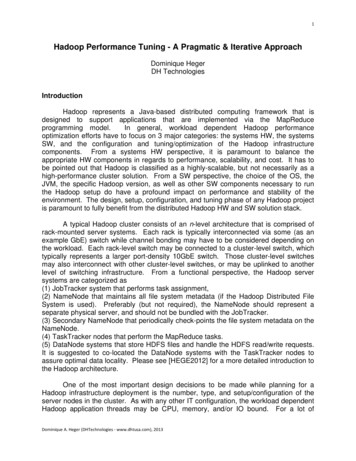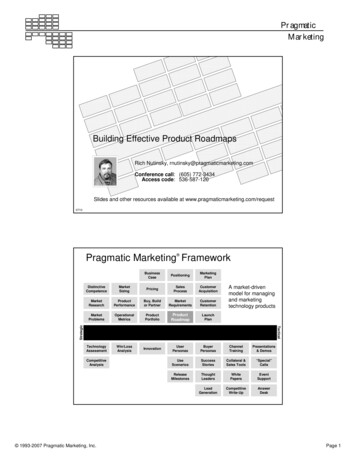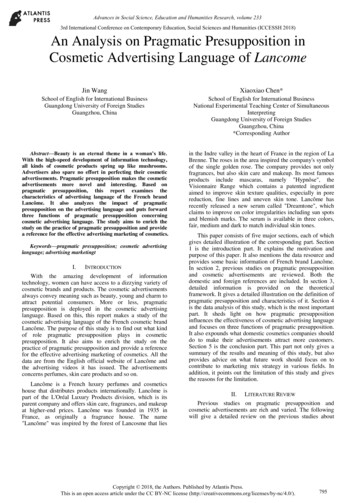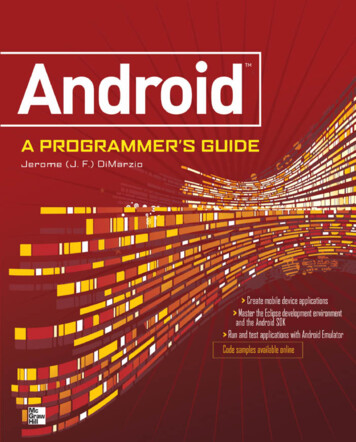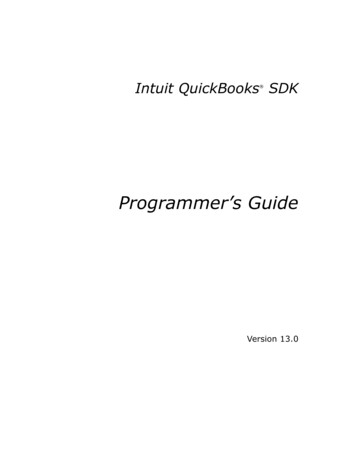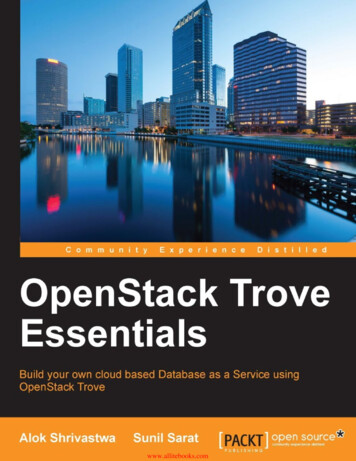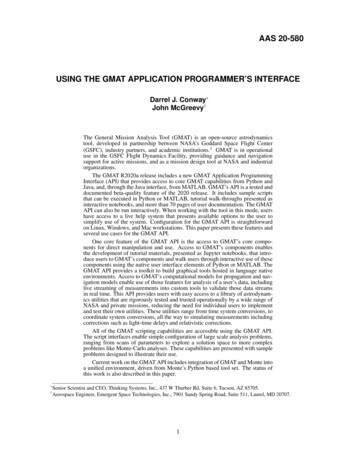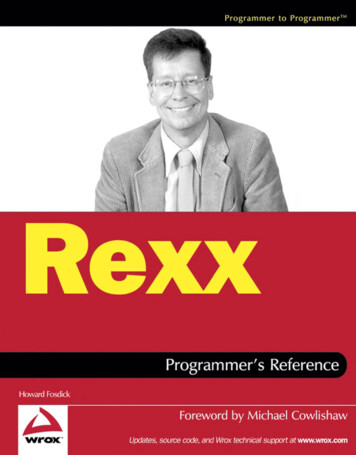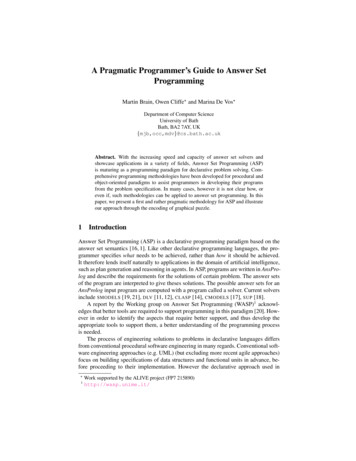
Transcription
A Pragmatic Programmer’s Guide to Answer SetProgrammingMartin Brain, Owen Cliffe? and Marina De Vos?Department of Computer ScienceUniversity of BathBath, BA2 7AY, UK{mjb,occ,mdv}@cs.bath.ac.ukAbstract. With the increasing speed and capacity of answer set solvers andshowcase applications in a variety of fields, Answer Set Programming (ASP)is maturing as a programming paradigm for declarative problem solving. Comprehensive programming methodologies have been developed for procedural andobject-oriented paradigms to assist programmers in developing their programsfrom the problem specification. In many cases, however it is not clear how, oreven if, such methodologies can be applied to answer set programming. In thispaper, we present a first and rather pragmatic methodology for ASP and illustrateour approach through the encoding of graphical puzzle.1IntroductionAnswer Set Programming (ASP) is a declarative programming paradigm based on theanswer set semantics [16, 1]. Like other declarative programming languages, the programmer specifies what needs to be achieved, rather than how it should be achieved.It therefore lends itself naturally to applications in the domain of artificial intelligence,such as plan generation and reasoning in agents. In ASP, programs are written in AnsProlog and describe the requirements for the solutions of certain problem. The answer setsof the program are interpreted to give theses solutions. The possible answer sets for anAnsProlog input program are computed with a program called a solver. Current solversinclude SMODELS [19, 21], DLV [11, 12], CLASP [14], CMODELS [17], SUP [18].A report by the Working group on Answer Set Programming (WASP)1 acknowledges that better tools are required to support programming in this paradigm [20]. However in order to identify the aspects that require better support, and thus develop theappropriate tools to support them, a better understanding of the programming processis needed.The process of engineering solutions to problems in declarative languages differsfrom conventional procedural software engineering in many regards. Conventional software engineering approaches (e.g. UML) (but excluding more recent agile approaches)focus on building specifications of data structures and functional units in advance, before proceeding to their implementation. However the declarative approach used in?1Work supported by the ALIVE project (FP7 215890)http://wasp.unime.it/
50M. Brain, O. Cliffe, and M. De VosSolutionProblemModelProgramInterpretSolveAnswer SetsFig. 1. The Four Box DiagramAnsProlog means that programs essentially act as their own specification. Thus theprocess of understanding, decomposing and encoding problem structures (the specification) is necessarily blurred with the process of solving the problem itself (the implementation).AnsProlog is increasingly being used to solve practical problems both in and outof the academic domain. At present it is our experience that developers who use thesesystems to solve real problems tend to develop either without a specific methodology,or build their own methodological process. Just as the community is trying to reachconsensus on language standards [22] and intermediate formats for program representation and such [15, 22], we feel there is a need to reach a similar consensus on practicalprocesses by which programs are developed and maintained. However, as with all programing techniques we cannot claim to know the best way to solve problems using ASP,all we can talk about is how we write programs and relate our experiences working ina number of domains. Thus, in this paper we do not try to document “best practice”,simply “our practice”. We hope that this can be the start of a discussion and that we, asa community, can start building up an idea of best practice.The structure of the remainder of paper is as follows, we start by addressing issuesrelating to the whole process of problem solving using ASP, specifically we focus onmethodological questions relating to how problems are captured. We then discuss somespecific observations relating to problem encodings themselves through a guided example. Finally we look at the process of resolving problems within existing AnsPrologprograms (debugging).2Towards a Development ProcessASP can be described via the four box diagram, as shown in Figure 1. One starts with aproblem which is modelled as a AnsProlog program. This program is passed then to asolver. The answer sets are then interpreted to obtain the solutions.A common problem we have found when encouraging students and collaboratorsfrom other fields to become active involved in developing applications using ASP isthat while they understand how the tools work (the solving link in Figure 1) and finished
A Pragmatic Programmer’s Guide for Answer Set Programming51models (the program box), they do not understand how to go from their problem to aprogram (the modelling link). As far as we know there is no documentation that we canpoint them to and say “this is how to solve a problem using ASP”. The authors of [8]give a very nice break down of how a logical model is structured and is currently thebest resource for this. However they present the models as a finished product and do notdiscuss the process, reasoning or tools that created them.3The MethodologyIn this section we provide a detailed description of our methodology for using ASPto solve problems. As a running example we will use the Hashiwokakero puzzle. Thepuzzles creators, Nikoli2 describe the puzzle as follows:Hashiwokakero is played on a rectangular grid with no standard size, although the grid itself is not usually drawn. Some cells start out with (usuallyencircled) numbers from 1 to 8 inclusive; these are the islands. The rest of thecells are empty.The goal is to connect all of the islands into a single connected group bydrawing a series of bridges between the islands. The bridges must follow certain criteria:1. Connect islands (the dots with numbers) with as many bridges as the number in the island.2. There can be no more than two bridges between two islands.3. Bridges cannot go across islands or other bridges.4. The bridges will form a continuous link between all the islands.We also use examples from our music composition system A NTON [3] and oursuperoptimisation application, TOAST [5] which are among the largest applicationsusing ASP.Although some debugging tools exist [4], we have come to believe that a more incremental, test-driven [2] approach allows for easy verification at every stage. While itdoes not make debugging tools superfluous, a systematic approach prevents programmers from making certain errors and increases productivity.3.1Step 1: Start SimpleWe advocate starting with a simplified model of the problem that to be solved, becauseit is much easier to build up a correct model into something more complicated than itis to fix a complicated but broken program. For example, in the case of A NTON westarted out composing one part for 8 notes. This point cannot be stressed enough, startsimple, start laughably simple, and work akero/rule.html
52M. Brain, O. Cliffe, and M. De VosExample 1. To start encoding our puzzle, we need to decide which literals to use torepresent each concept. We need to consider what information will be in the instances,what the constraints are and what information you wish to infer. In this case, we decidedto use the following:AtomConcept representedInstance Specific Informationcol(X)There is a column labelled X (ascending integers from 1).row(Y)There is a row labelled Y (ascending integers from 1).island(X,Y,N)There is an island in column X, row Y with value N.Information to be InferredsingleHorizontal(X,Y) There is a single horizontal bridge in column X, row Y.doubleHorizontal(X,Y) There is a double horizontal bridge in column X, row Y.singleVertical(X,Y) There is a single vertical bridge in column X, row Y.doubleVertical(X,Y) There is a double vertical bridge in column X, row Y.At this stage, our program now looks like as Listing 1.row(1.height).col(1.width).Listing 1. The first step towards our Hashiwokakero programDeciding the meaning of the base literals should be enough to create and visualise(see next step) a problem instance. It is best to start with as small an instance as is meaningful, as otherwise it will be difficult to check by hand. This also helps mitigate anyscaling issues during development. Given we are advocating incremental development,one does not want to have to wait more than a few seconds per run during development,so one needs to pick an appropriately sized example.Listing 2 shows (with modified formatting) an instance of our puzzle.3.2Step 2: VisualisationThe next step is a visualisation or post-processing mechanism. This is effectively theinterpretation link in the four box diagram. Post-processing and visualisation are oftneglected parts of the development process, but very important ones as they allow thedeveloper to see the program and its development in terms of the initial problem andsolution, allowing a much more intuitive development process. This stage closes the semantic gap between the program encoding and the problem domain and aids debuggingas it allows programmers to see what they wrote and easily compare it with what theyintended to write. As argued in [6], when writing programs there is often a mismatchbetween the answer set you get and what you expected. Visualisation makes it mucheasier to see what one has, and specifically it often makes it easier to see when what one
A Pragmatic Programmer’s Guide for Answer Set Programming53#const height 13.#const width d(10,2,3). island(11,5,4).island(10,4,3). island(11,7,4).island(10,11,4). island(11,10,2).island(10,13,2).Listing 2. An Hashiwokakero instancehas is incorrect. How the visualisations/interpretations are produced is up to the programmer and different types of program will lend themselves to different visualisationand processing approaches. One possibility is using a scripting language (e.g. Perl) andASCII art. A more sophisticated choice would be ASPV IZ [9], a ASP visualisation toolusing AnsProlog as its representation language. GraphViz 3 is also frequently a usefultool for visualising problems solutions.The utility of visualisation cannot be overstated. It is often the most time consumingpart of development but it does pay dividends by simplifying the process of isolatingprogramming errors. After this it should be possible to visualise all of the elements ofthe full search space.Example 2. The visualisation program written in ASPV IZ for Hashiwokakero can befound in Listing 3 (see [9] for a description of the language). The rules produce graphical artifacts for each island, shown as an ellipse containing the number of requiredbridges and the connecting bridges. An example of the output, for the program andinstance given so far can be found in Figure 2.3.3Step 3: The Search Space GeneratorThe first part of the program to be written should be the search space generator. Thistends to be a set of choice rules that define the search space of the problem in question4 ;to start with, this should give an answer set for each possible element of the searchspace. In the case when the problem being solved is co-NP, search generation is especially important. Working with programs with no answer sets is problematic. Thisshould be obvious if one accepts the argument [6] that one knows there is a bug if there34http://www.graphviz.org/We are of the opinion that all uses of ASP should effectively be phrased as search problems.As a consequence, we see the ‘hard’ part of the problem as the search phase. We note thatthere is a view that the procedural, data processing side is more significant.
54M. Brain, O. Cliffe, and M. De Vos% Draw islands and numbersdraw ellipse(dflb,p(X*16,Y*16),14,14) :- island(X,Y,N).draw text(dflf,c,c,p(X*16,Y*16),N):- island(X,Y,N).% Draw single bridgesdraw line(dflb,p(X*16,(Y*16)-8),p(X*16,(Y*16) 8)):verticalBridge(X,Y), not doubleVertical(X,Y).draw line(dflb,p((X*16)-8,Y*16),p((X*16) 8,Y*16)) :horizontalBridge(X,Y), not doubleHorizontal(X,Y).% Draw double bridgesdraw line(dflb,p((X*16)-8,Y*16 2),p((X*16) 8,Y*16 2)) :- doubleHorizontal(X,Y).draw line(dflb,p((X*16)-8,Y*16-2),p((X*16) 8,Y*16-2)) :- doubleHorizontal(X,Y).draw line(dflb,p(X*16 2,(Y*16)-8),p(X*16 2,(Y*16) 8)):- doubleVertical(X,Y).draw line(dflb,p(X*16-2,(Y*16)-8),p(X*16-2,(Y*16) 8)):- doubleVertical(X,Y).Listing 3. The visualisation program for HashiwokakeroFig. 2. Visualisation of an unsolved instance of the Hashiwokakero puzzleis a difference between the expected and given answers. When the expected result isthat no answer sets are produced and one gets no answer sets, how does one know if thecode is working correctly or whether one has introduced a contradiction? Just using thenumber of branches or other solver performance stats is not reliable. Thus one wants tospend as much time as possible with answer sets, to the point of commenting out someconstraints or deliberately working with instances that are ‘incorrect’.Example 3. We now need to add rules to generate the search space. The program up tothis stage can be found in Listing 4. Adding these first rules allows us to see the solutiontaking shape as we build the model.We now run our program together with the instance provided in Listing 2. Fromthis, we obtain an answer set for every combination of bridges (a very large number).At this point, we do not yet care whether bridges join up or not. We can exploit therandomisation functionality of most answer set solvers to generate a small selection ofanswer sets which are visualised in Figure 3.3.4CommentingComments are very important during development. AnsProlog is very expressive andallows modelling of some very sophisticated concepts with very little code. Without
A Pragmatic Programmer’s Guide for Answer Set Programming55row(1.height).col(1.width).%% We need to know which squares contain island%% So we project out the value of the islandisIsland(X,Y) :- island(X,Y,N).%% For each square that is not an island, pick whether it should contain%% a bridge or not and if so, what kind of bridge.1 { empty(X,Y), singleHorizontal(X,Y), doubleHorizontal(X,Y),singleVertical(X,Y), doubleVertical(X,Y) } 1 :- row(Y), col(X),not isIsland(X,Y).Listing 4. Adding the search space for HashiwokakeroFig. 3. Example outputs for random bridge assignmentscomments this compactness can lead to terseness and unreadability (commonly referredto as write-only code in procedural languages). Normally each rule or group of relatedrules will be preceded by a comment, saying (in natural language) what aspect or ideafrom the problem it is intended to encode and (in the few cases where the encodingis complicated enough), how it is encoded. As well as making the program more intelligible, heavy commenting is very important for debugging and maintenance as itexpresses, as much as is possible, what was intended by the code. As noted in [6] a bugin an AnsProlog program is a mismatch between what is written and what was intended.When no expression of intent is available except for the rules, then only the programmerwho wrote the code can debug it, and generally only while writing it. Maintenance andfurther development become very difficult as first one has to infer what the programmerwas thinking when they wrote the code. Given the (frequently) small semantic gap between the comments and the code, natural language generation may offer an interestingroute to program support/debugging tools. If what is written does not provide a correctdescription of the problem, then generally one can see which part of the description isa problem. We also tend to use comments to record what each of the key propositionspresents about the world, i.e “move(T,X,Y) is known if the move at time step T is toposition (X,Y)”. Ideally it should be possible to read the comments top to bottom as adescription of the model.
56M. Brain, O. Cliffe, and M. De Vosrow(1.height).col(1.width).%% We need to know which squares contain island%% So we project out the value of the islandisIsland(X,Y) :- island(X,Y,N).%% For each square that is not an island, pick whether it should contain%% a bridge or not and if so, what kind of bridge.1 { empty(X,Y), singleHorizontal(X,Y), doubleHorizontal(X,Y),singleVertical(X,Y), doubleVertical(X,Y) } 1 :- row(Y), col(X),not isIsland(X,Y).%% A single horizontal bridge must lead to another single bridge or an island:- singleHorizontal(X,Y), not singleHorizontal(X 1,Y), not isIsland(X 1,Y).%% Likewise for double horizontal bridges:- doubleHorizontal(X,Y), not doubleHorizontal(X 1,Y), not isIsland(X 1,Y).%% Similarly for vertical bridges:- singleVertical(X,Y), not singleVertical(X,Y 1), not isIsland(X,Y 1).:- doubleVertical(X,Y), not doubleVertical(X,Y 1), not isIsland(X,Y 1).Listing 5. The first increment of HashiwokakeroFig. 4. An answer set visualisation of Hashiwokakero after the first increment.3.5Step 4: Incremental DevelopmentDevelopment now progresses in an incremental fashion, using very small increments. Aset of rules (normally corresponding to one comment / idea) is written, then the solveris re-run and the answer set(s) visualised. This may seem slow but it removes a lot ofbugs and saves time while trying to diagnose the causes of problems. In more complexapplications the visualisation program may need to be updated along with the programto show the effect of new literals.Example 4. Increment One: We now add rules saying that bridges must continue intheir existing direction (and with the same width) or stop at an island. The program atthis stage is shown in Listing 5. Note that these are only phrased in terms of increasingrow / width as the decreasing case follows via symmetry. A visualisation of one theanswer sets of our puzzle after we added the first increment is shown in Figure 4.
A Pragmatic Programmer’s Guide for Answer Set Programming57%% We want to be able to talk about either kind of horizontal / vertical bridgehorizontalBridge(X,Y) :- singleHorizontal(X,Y).horizontalBridge(X,Y) :- doubleHorizontal(X,Y).verticalBridge(X,Y) :- singleVertical(X,Y).verticalBridge(X,Y) :- doubleVertical(X,Y).%% A horizontal bridge cannot start a vertical bridge:- horizontalBridge(X,Y), verticalBridge(X,Y 1).%% Neither can an empty square:- empty(X,Y), verticalBridge(X,Y 1).%% Correspondingly for vertical bridges:- verticalBridge(X,Y), horizontalBridge(X 1,Y).:- empty(X,Y), horizontalBridge(X 1,Y).Listing 6. The second increment of HashiwokakeroFig. 5. An answer set visualisation of Hashiwokakero after the second increment.Example 5. Increment Two: From the visualisation in Figure 4 is is clear that answersets are beginning to resemble solutions but a few conditions are missing as there arecases where bridges are running into each other or starting from nothing. Thus weproject the existence of horizontal / vertical bridges and prevent the other kind fromstarting immediately after them. Similarly for empty squares. The projection is a tradeoff between the number of literals and the number of rules. Given that rules are moreoften the limit of scalability, it is often worth doing. The rules added to the program areshown in Listing 6 and its output in Figure 5.Example 6. Increment Three: The bridges are beginning to look correct, however thevisualisation (Figure 5) points out a few conditions that have been missed. As we havebeen focusing on the ‘next’ location, we have edge conditions at the border. These areeasily removed as there should never be vertical bridges in the top or bottom row, norhorizontal ones in either edge. The code in Listing 7 is added to our program whichresults in output like Figure 6.Example 7. Increment Four: The bridges look correct but are a little sparse, so the nextcondition to add is the number of bridges coming in to each island. The obvious way to
58M. Brain, O. Cliffe, and M. De Vos%% No vertical bridges in the top or bottom rows:- verticalBridge(X,1).:- verticalBridge(X,height).%% Likewise no horizontal bridges in the edge columns.:- horizontalBridge(1,Y).:- horizontalBridge(width,Y).Listing 7. The third increment of HashiwokakeroFig. 6. An answer set visualisation of Hashiwokakero after the third increment.do this is using a weight constraint. The additions to the program are shown in Listing 8.Again, the visualisation (Figure 7) makes it relatively easy to check that the effect ofthese rules matches the intend behind them.Example 8. Fifth and final Increment: Now for the last constraint: all of the islands needto be connected. Careful examination of the output (Figure 7) will show that the islandsare not connected. We formalise connectivity as reachability from a unique startingpoint and then require that all islands must be reachable. This raises the question ofhow to pick a unique starting point. We opt for the easiest solution of adding this tothe instance requirements. The final addition to our program is shown in Listing 9. Theentire program resulting in a complete (and unique) solution (Figure 8)3.6Coding ConventionsA number of coding conventions have been found to be useful and practical. Firstlyliterals are only ever used with one arity. This means that omissions of variables shouldbe a detectable problem, rather than silently changing the meaning of the programs.Likewise, where at all possible, variable names are only ever used for one domain, i.e.T will always be a quantification over the time() domain, if X is a distance, it willalways be used as one, in the same direction. These meanings are program specific, thekey point is that it should be consistent across the program. Likewise the position, andordering of variables should always be the same. If several literals refer to a 2D positionat a given time step then they will all start with (T,X,Y,.), etc.
A Pragmatic Programmer’s Guide for Answer Set Programming59%% For an island to be correct connected the number of bridges%% entering a island must equal the weight at the island.correctlyConnected(X,Y) :- island(X,Y,N),N [ singleHorizontal(X-1,Y) 1,doubleHorizontal(X-1,Y) 2,singleHorizontal(X 1,Y) 1,doubleHorizontal(X 1,Y) 2,singleVertical(X,Y-1) 1,doubleVertical(X,Y-1) 2,singleVertical(X,Y 1) 1,doubleVertical(X,Y 1) 2 ] N.%% All islands must be correctly connected:- isIsland(X,Y), not correctlyConnected(X,Y).Listing 8. The fourth increment of HashiwokakeroFig. 7. An answer set visualisation of Hashiwokakero after the fourth increment.3.7Extension and MaintenanceOnce the program is working, development shifts to extension and maintenance. Whilepreviously we were intentionally cutting down the space of possibilities, in the maintenance and enhancement phase the aim is often to make changes without inadvertentlyremoving portions of the solution space (or making the program inconsistent, i.e. removing all of the solutions). Regression testing was used during the development ofA NTON to address this problem. If we view ASP as solving a search problem, then thesolution is a point in the search space and can be used as an initial condition for thesearch. If it gives the (single) solution that was found originally then it is still a solution, if it is inconsistent then the space of solutions has decreased, indicating a possibleerror. Once the original composition system was working, its output was checked byan expert and a collection of valid (and respectively, invalid) pieces was created. Aftereach step of the development (one or more new rules), the regression tests could be runto automatically check that each of these was/was not obtainable and thus that no bugshad been introduced. This helped isolate bugs early in the development cycle and add aconsiderable degree of certainty to the development process.
60M. Brain, O. Cliffe, and M. De Vos%% The unique start is reachablereachable(X,Y) :- uniqueStart(X,Y).%% If an island is reachable then all neighbouringreachable(X-1,Y) :- isIsland(X,Y), reachable(X,Y),reachable(X 1,Y) :- isIsland(X,Y), reachable(X,Y),reachable(X,Y-1) :- isIsland(X,Y), reachable(X,Y),reachable(X,Y 1) :- isIsland(X,Y), reachable(X,Y),bridges are X 1,Y).verticalBridge(X,Y-1).verticalBridge(X,Y 1).%% If a horizontal bridge is reachable then so are neighbouring bridges/islandsreachable(X-1,Y) :- horizontalBridge(X,Y), reachable(X,Y), horizontalBridge(X-1,Y).reachable(X 1,Y) :- horizontalBridge(X,Y), reachable(X,Y), horizontalBridge(X 1,Y).reachable(X-1,Y) :- horizontalBridge(X,Y), reachable(X,Y), isIsland(X-1,Y).reachable(X 1,Y) :- horizontalBridge(X,Y), reachable(X,Y), isIsland(X 1,Y).%% Likewise vertical bridgesreachable(X,Y-1) :- verticalBridge(X,Y),reachable(X,Y 1) :- verticalBridge(X,Y),reachable(X,Y-1) :- verticalBridge(X,Y),reachable(X,Y 1) :- ).verticalBridge(X,Y 1).isIsland(X,Y-1).isIsland(X,Y 1).%% Every island must be reachable:- isIsland(X,Y), not reachable(X,Y).Listing 9. The final additions to HashiwokakeroFig. 8. The visualisation of the solution to the Hashiwokakero.3.8Generating Program Instances and EncodingsLiterature on ASP often refers to splitting programs into instances and encoding. Thisis an intuitive division because in many cases there is a general class of problems anda particular instance of the problem we wish to solve. However there is often an assumption that this split is syntactic; facts for the instance and rules for the encoding.From our experience, this is not always the case. It is perfectly possible for the instanceto include constants, extra constraints as well as atoms. Constants tend to be the mostsignificant because these often alter the remaining program significantly.In the case where the instance encoding is non-trivial we normally write a script thattakes obvious, human readable parameters (as in A NTON ) or a problem specific inputformat (as in TOAST ) and generates at least the instance if not the whole program.This is where the distinction between instance and encoding begins to break down, as
A Pragmatic Programmer’s Guide for Answer Set Programming61part of the reason for having these scripts is combining the necessary program fragments, which are often instance specific. A NTON includes a #include construct tomanage dependencies between program fragments and simplify program generation.In TOAST , the search program component included the architecture file which couldbe considered both instance and encoding. If one thinks of the visualisation scripts asthe interpretation arrow in the four-box diagram Figure 1, then the program generationscript that puts together the AnsProlog program is the representation arrow.4Debugging ProgramsWhile the current debugging tools [6, 4] have their use, we have come to believe thatexisting tools do not yet provide the necessary support for programmers. The mainproblem is the amount of time the interface takes because one has to (implicitly orexplicitly) mark which parts of the program are right and wrong. In practise this is tooslow. One may think that it is no coincidence that none of the papers on debugging givemore than a trivial, propositional example. All of the existing debuggers are primarilyfocused on computation of the reasons why certain properties of the answer sets hold.A topic that has received little research or implementation attention is the question ofhow to present the resultant symbolic information back to the user. This problem isdiscussed in more detail in [7].However, with careful, incremental development and computing and visualisingmodels after each change the programmer will already have a rough idea about whatcaused the problem and probably also why. The regression tests should catch the moreobscure cases the programmer did not necessarily think of when going back and changing an older definitions.5ConclusionIn this paper we have presented an anecdotal methodology for software development inanswer set programming. In summary:1. Our approach is incremental and test-driven, allowing for early error detection.2. After a suitable characterisation of the key concepts is determined, we recommendthat a visualisation tool for the answer sets is used.3. Having a graphical, auditory or more readable representation of the answer sets interms of the problem domain will make it a lot easier to spot problems with thecode.4. Code documentation is even more important in ASP than it is in procedural languages. As errors are typically the result of a misalignment between the what wasmeant and what was written down, clearly stating what was intended in a humanreadable form near to the relevant code makes identifying such errors easier.5. The methodology is constructed around the notion that all our problems are searchproblems.6. We model the entire search space first, before adding constraints to find acceptablesolutions.
62M. Brain, O. Cliffe, and M. De Vos7. The characterisation of solutions and the constraints that reduce the search spaceshould be done incrementally in order to detect bugs as early as possibl
A Pragmatic Programmer's Guide to Answer Set Programming Martin Brain, Owen Cliffe? and Marina De Vos? Department of Computer Science University of Bath Bath, BA2 7AY, UK fmjb,occ,mdv g@cs.bath.ac.uk Abstract. With the increasing speed and capacity of answer set solvers and showcase applic
